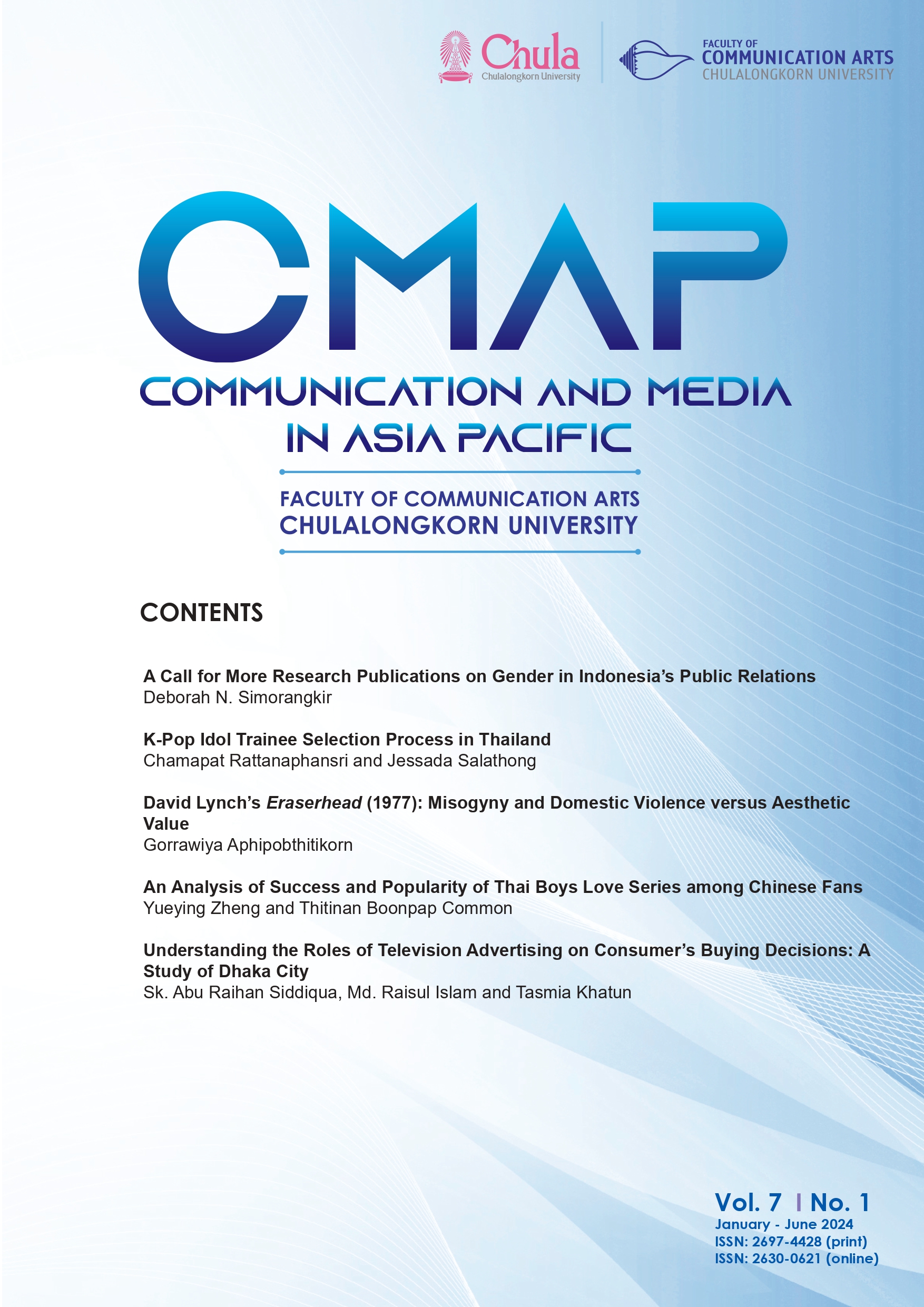David Lynch’s Eraserhead (1977): Misogyny and Domestic Violence versus Aesthetic Value
Main Article Content
Abstract
The study offers a critical analysis of David Lynch’s 1977 film Eraserhead, focusing on the film’s presentation of violence and the interplay of power structures within the narrative. The research employs a well-defined framework utilizing in-depth interviews and rigorous data analysis. The primary data sources for the study encompass various elements, including a brief explanation of the film’s synopsis, an analysis of detailed mise en scène, existing theoretical literature, and insights from David Lynch’s own career stance. Eraserhead (1977), examined from diverse viewpoints, is viewed by some as delving into complex psychological and existential themes through symbolism, going beyond gender-specific criticisms. Interpretations differ widely, prompting varied audience reactions. The film provides an opportunity to transcend accusations of misogyny, proposing that the portrayal of sex and violence in cinema can contribute to aesthetic values and deeper meanings. Future research should focus on expanding the range of critics to encompass a wider variety of perspectives, ideologies, disciplines, and cultural backgrounds. This will ensure a more comprehensive understanding and minimize biases stemming from limited representation.
Article Details
References
Barney, R. (2009). David Lynch: Interviews (Conversations with Filmmakers Series). University of Mississippi Press.
Bhattacharjee, S. (2019). A critical analysis of David Lynch’s Eraserhead (1977): Whose dream is it after all? Research Review International Journal of Multidisciplinary, 4. https://
www.academia.edu/39479577/A_Critical_Analysis_of_David_Lynchs_Eraserhead_1977_Whose_Dream_is_it_After_All
Bryant, J., & Zillmann, D. (Eds.). (2002). Media effects: Advances in theory and research (2nd ed.). Lawrence Erlbaum Associates.
Burningham, B. R. (2010). David Lynch and the Dulcineated World. Cervantes, 30(2), 33-56. https://doi.org/10.3138/cervantes.30.2.033
Carr, J. (2014). Eraserhead: David Lynch’s ‘subconscious experience’ released on criterion. https://filmint.nu/Eraserhead-david-lynchs-subconscious-experience-on-criterion/
Devlin, W. J., & Biderman, S. (2011). The philosophy of David Lynch. University of Kentucky Press.
Fischer, L. (2003). Designing women: Cinema, Art deco, and the female form. Columbia University Press.
Freud, S., & Crick, J. (1999). The interpretation of dreams. Oxford University Press.
Hooks, B. (1997). Cultural criticism & transformation. Media Education Foundation.
Hayward, S. (1996). Key concepts in cinema studies. Routledge.
Jaffe, E. (2007). Reel to real: Psychology goes to the movies. APS Observer, 20(3). https://www.psychologicalscience.org/observer/reel-to-real-psychology-goes-to-the-movies
Jespersen, T. C. (2000). The bitter end and the lost chance in Vietnam: Congress, the Ford Administration, and the battle over Vietnam, 1975–76. Diplomatic History, 24(2), 265–293. https://doi.org/10.1111/0145-2096.00212
Knight, T. (1977). Haunted patriarchy and abjection of identity in David Lynch’s Eraserhead. Arts University Bournemouth.
Lafky, S. (1999-2000). Gender, power, and culture in the televisual World of twin peaks: A feminist critique. Journal of Film and Video, 51(3/4), 5-19.
Lev, P. (2000). American films of the 70s: Conflicting visions. University of Texas Press. https://doi.org/10.7560/747159
Lynch, D., & McKenna, K. (2018). Room to dream: A life. Canongate Books.
Mcleod, S. (2023). Psychoanalysis: Freud’s psychoanalytic approach to therapy. https://www.simplypsychology.org/psychoanalysis.html
Mulvey, L. (1975). Visual pleasure and narrative cinema. Screen, 16(3), 6-18.
Murray, M. (2022). Abortion, sterilization, and the universe of reproductive rights. William & Mary Law Review, 63(5), 1599-1638.
Münsterberg, H. (1916). The photoplay: A psychological study. D. Appleton and Company.
Richardson, M. (2006). Surrealism and cinema. Berg.
Rodley, C. (1993). Lynch on Lynch. Faber and Faber.
Ryan, S., Bushman, D., Amick, M., Stewart, C., Hallam, L., McFarland, M., Bowden, L., Hayes, M. C., Klein, H., & Snow, P. (2019). The women of David Lynch: A collection of essays. Fayetteville Mafia Press.
Sheen, E., & Davison, A. (2004). The cinema of David Lynch: American dreams, nightmare visions. Wallflower Press.
Sitney, P. A. (1978). David Lynch’s industrial symphonies. Princeton University Press.
Todd, A. (2012). Authorship and the films of David Lynch: Aesthetic receptions in contemporary Hollywood. Bloomsbury Publishing.
Ussher, J. M., Chrisler, J. C., & Perz, J. (Eds.). (2020). Routledge international handbook of women’s sexual and reproductive health. Routledge.
Verrone, W. E. (2011). The avant-garde feature film: A critical history. McFarland.
Wilson, E. (2007). The strange world of David Lynch: Transcendental irony from Eraserhead to Mulholland. Continuum Publishing.

